Tribal Culture
Tribal Culture There are many indigenous communities in Bangladesh and each of these communities has its own culture and tradition. Some of them may even have cultural distinctions within their different clans. But some traits are generally common among most tribes. For instance, originally most tribes had been animists.
Celebrations and Festivals Most tribes have festivities, particularly dancing and singing. Most of these festivals are celebrated by drinking a lot of alcoholic beverages. A very popular festival of the manipuris is a type of Gopi dance celebrating the love of radha and krishna. In spring, Manipuris, santals and oraons celebrate Holi when they drench each other with colour. The Oraons count their year from the month of Falgun. Young Oraon men and women celebrate the first night of the year dancing around a fire. Drums, cymbals and flute provide the music.
Most religious rites and festivities of the Manipuris and the garos are based on the seasons of the year. For a whole month, starting with the midnight of the Holi full moon, young Manipuri men and women dance in the open. They also celebrate the rice harvest through singing contests.
The youths and maidens of the Malpahari tribe also spend the night in festivities, singing, dancing, and consuming alcohol. Santals celebrate the harvest or sahrai festival for three to four days. Like the Manipuris, young Santal men and women dance and sing to the accompaniment of cymbals and flute. Like Manipuri and Santal youths, Garo ones also sing and dance collectively at the oyanggala festival, which is connected with sowing of seeds and harvesting of crops.

These celebrations take place at night when the young Garo men and women drink and dance. Buffalo horns are blown on the occasion. As night advances, the music and dancing become wilder, as alcohol is consumed freely. The wild dancing at Garo oyamgala is intended to appease evil spirits. Food is also offered to the spirits then. The Maghs spend the first three days of the Maghi year singing, dancing and drinking.
Religious beliefs and taboos Except for the Sangsarek of the Garos and buddhism of some tribes of Chittagong and the chittagong hill tracts, all other tribes have no specific religion. They regard their ancient rites, beliefs and customs as their religion. The Samsarek of the Garos is also close to extinction. Most of them have by now become Christians. However, they still follow certain rites of Samsarek. Most Santals are Christians now but they observe their own tribal rites. The periods of the full moon and the dark of the moon are of special significance to the Oraons, Manipuris and Buddhist tribes. Many religious and cultural rites take place during the full moon.
The Oraons follow the sayings of dak and khana. They have many superstitions regarding journeys. For example, Oraons will not undertake a journey if they stumble at the start, someone beckons from behind, a house-lizard calls out, a message is delivered about someone';s death, a corpse appears on the way, a crow caws on a dry twig, or an empty pitcher comes in view. When Oraons start tilling the field, they will do so from the east. They will wait for an auspicious day to begin building a house.
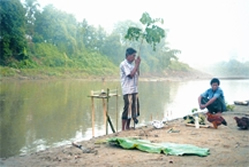
They believe that it is inauspicious to comb hair at night, to throw women's hair outside, to sweep a house at sunset, to give something to someone after dusk, to hear an owl hooting, or a dog weeping at night. Oraons also have certain superstitions about cows. Thus they give away the first yield of milk from a lactating cow, and will not let a menstruating woman or a woman who has not completed the period of confinement after childbirth enter a cowshed. Women must not take the name of the husband's elder brother. Oraons believe that magic can be used to enthrall women. They also believe in the power of spells and charms. For protection against witches they go to Ayurvedic physicians. The Garos do not believe in witches. However, they do believe that some men become tigers at night and attack and kill cattle. They also believe that those who are killed by wild animals are reborn as animals. The Oraons believe that the spirit of a still-born child is reborn and that some Ayurvedic physicians have the power to prevent the appearance of evil spirits.
There are many superstitions and taboos regarding women. Thus, a pregnant Oraon woman will not eat rats or eels for fear of making her child hideous. After childbirth she is forbidden to eat khesari (a type of lentils), potatoes, or stale food. She is not allowed to drink cold water. Manipuris do not allow their pregnant women to go out in the open with their hair loose; they are also not allowed to go far at night, nor to cross a river or a bridge.
Malpaharis believe that spirits may possess a woman at her wedding and that they may possess both mother and newborn at childbirth. They are always on the lookout for danger. khasias and mundas believe that the spirits of dead children and of one's ancestors may visit a house and therefore they erect a stone platform for these spirits. All tribes believe in household gods that regulate their well being.
Concept of Creation According to the Garos, a woman named Nastunpantu created the earth from soil brought up by a tortoise from the bottom of the sea and then dried it with the help of the sun god to make it habitable. Manipuris legends narrate how the world was composed entirely of water. Then the great guru Shidara made 9 gods and 7 goddesses. The gods threw soil from the heavens and the goddesses danced on the soil and flattened it to create the earth. The Khasias believe Thyu Blauu first created the earth and then a man and woman from whom the entire human race descended.
Farm work Some tribes regard the earth as mother; so they worship the earth-mother before sowing crops. Oraons revere the cropland and believe that it is the earth-mother's menstruation that produces crops. This is why they observe a number of ceremonies where the earth is treated as a menstruating or pregnant woman. Some tribes give the land special food, as is the custom in the case of a pregnant woman. The Oraons and the Santals reverently apply vermilion spots on their farm implements. Among Garos, Manipuris, Santals and a few other tribes men and women work together in fields. The men clear the jungles and till the soil while the women, as symbols of fertility, sow seeds and do the transplanting. All tribes celebrate seed planting and crop harvesting in their own colourful ways. Young men and women sing and recite rhymes as they carry the ripe crops home.
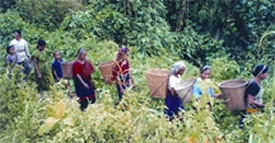
Marriage There are similarities as well as dissimilarities in the wedding rites of different tribes. Most tribal marriages are based on love matches, with the bridal couple getting to know each other before marriage. Oraons do not allow child marriage, nor weddings during the months of Chaitra, Bhadra and Paus. Grooms have to pay a bride price. Pre-wedding ceremonies include seeing a bride, panchini (confirmation of a match) and gaye halud (applying turmeric paste on the bodies of both groom and bride). Women of both sides sing nuptial songs on the day of wedding.
Oraons and Manipuris put up colourful wedding pandals. Oraons install mabgalghat, a vessel of water, as a symbol of divine blessings in the wedding pandal. At the wedding ceremony which takes place in the pandal, the groom and the bride daub each other's forehead with vermilion as women of both parties raise uludhvani (a sound produced by quickly turning the tongue in the mouth).
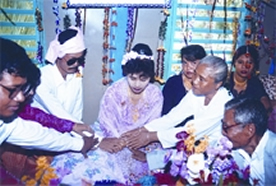
Among both Oraons and Manipuris, the bridal couple go round the pandal to be greeted with paddy and durva grass. Among the Manipuris the groom is welcomed by lighting a pradip (oil lamp) and his feet are washed by a young boy. At this time kirtan is sung and music is played. Two women from both sides release a pair of taki fish symbolising the groom and the bride into water.
It is a good omen if the pair of fish move side by side in the water. In a similar ceremony among the Garos, a cock and hen, with throats slit, are thrown to the ground. It is a good omen if, while they are in their death throes, the two come together to die. Otherwise, it is an ill omen and must be remedied through prayer and incantation by a khamal (mendicant). The gods are offered special food on the occasion so that they may bless the couple. A Manipuri bride comes to visit her parents for the first time on the fifth day after marriage, providing an occasion for a lavish feast. According to tribal custom, all members of the clan are invited to this ceremony and they come with presents of rice, meat, fowls, pigs, money or alcohol.
Among the Magh, young men and women get an opportunity to know each other closely at the new year festival. This is the time they choose their partners, subject to the approval of their parents. Girls of the Garo, Khasia, Tippra and Magh tribes go to the market to buy and sell goods. This again provides an opportunity for boys and girls to know each other more closely and select partners and then marry with the approval of their parents. Young men and women among the Santal, Garo and Manipuri tribes work together in the fields, giving them an opportunity to select their life partners.
chakmas cannot marry during the dark of the moon, full moon, or eclipse. Oraons, Santals, Khasias, Garos and Manipuris cannot marry within their own clans. Manipuris are forbidden to marry close relations. Members of the same Garo clan regard each other as brothers and sisters, and so cannot marry within the clan. However, Maghs marry within their clan as they discourage inter-clan marriages. Marriage between cousins is, however, forbidden, as is marriage between a man and his father's sister or mother's sister.
A Santal wife becomes part of her husband's clan. Magh men cannot marry again unless the wife is barren or mentally ill. Divorced and widowed women are permitted to remarry among both Maghs and Oraons. Divorce is permitted on the grounds of incompatibility, impotence or the wife's infidelity. However, though divorce is allowed among the Oraons, Khasias, Chakmas and Maghs, it is rather rare.
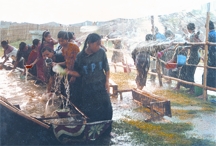
At times a young Garo woman chooses a Garo boy, marries him and keeps him at her parents' home. Such marriages are rare these days. However, some tribes, such as the Oraon, allow their boys and girls to elope and marry, with subsequent parental approval. Oraon and Santal wives put vermilion on their forehead or in the parting of their hair. Except among the Maghs, marriage within the clan is considered disgraceful and the guilty are expelled from the village.
It is a sin for the Khasias not to marry. Khasia women may have more than one husband at a time on grounds of the first husband's impotence or debauchery, desire to have more children or strong sexuality but this rarely happens. A Khasia woman cannot marry someone from another tribe. A Khasia girl may invite home a chosen boy from an approved clan, live together for a few days and, if she finds him acceptable, may marry him with the approval of both families. In Khasia weddings, women cannot accompany the groom's party to the bride's house. Among the Oraons, however, women can do so. After being blessed by his mother and elders, the Khasia groom leaves his mother's house wearing dhuti and turban and accompanied by the bridal party. Khasia wedding feasts consist of rice and dry fish, followed by alcohol. Three pieces of dry fish are offered to the gods to seek divine blessings for a new couple. Among the matriarchal Khasia and Garo tribes, the groom becomes a ghar jamai (part of his in-laws' house). Chakma weddings take place at the groom's house after the two sides have agreed and exchanged thinks. A Manipuri groom wears dhuti and turban and the bride wears the traditional gathered skirt, blouse, and peaked head dress.
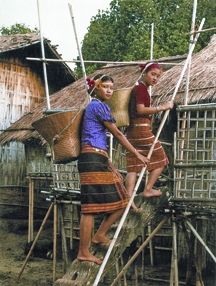
While some tribes allow divorce, it is rare. In case a divorce becomes inevitable, both husband and wife have to give their consent as do the elders of the clan. The party responsible for the divorce has to pay compensation to the other party. Among the Chakmas and Maghs, the cost of maintenance of minor children has to be borne by the husband. Among the Khasias, either the couple or someone else has to notify the clan chief about the divorce. The chief allows the couple time for reconciliation. If this does not work, an announcement is made of the breakup of the marriage. The person responsible for divorce has to pay the other party some compensation. Among the Khasias it is usually the wife who is held responsible for divorce. If the husband is responsible, he is caned or given a beating with shoes; his face is smeared with lime and black paint and his head is shaved. A pregnant woman cannot be divorced. A widow may marry a year after her husband's death.
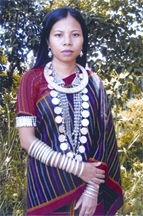
Dresses The men of Oraon and many other tribes commonly wear dhutis and their women wear saris. There was a time when some tribes used to wear tree leaves to cover the lower part of the body. The Garos used to wear barks of trees, which had been pounded and softened to resemble thin cloth. Lower-class Garos still wear nengti or a tiny piece of cloth which merely cover the genitals. Some tribes living in the deep forests of the Chittagong Hill Tracts still wear tree leaves as their only dress. Santal dresses are called panchi, panchatat and matha. The main dress of the Chakmas is the lubgi, worn with a shirt. Their women wear a red and black sarong, called pindhan, plus a blouse and a scarf called khadi. Magh women cover their body from chest to knees with a thami (sarong) over a full-sleeved blouse.
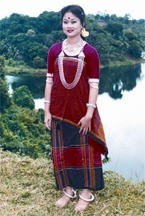
Ornaments and cosmetics There is very little variety in the ornaments that tribal women wear. In north Bengal they wear almost identical ornaments. Santal and Oraon women wear ornaments on their hands, feet, nose, ears and neck. Oraon women peak up their hair on the head and wear a tikli on the forehead. Chakma women wear bangles and anklets, as well as coin earrings and necklaces. Garo women do up their hair in buns, which they then adorn with flowers. Magh women use a herbal powder or wood paste to lighten their faces.

Food and drink The tribals eat everything except their totems. The Garos do not eat cats as the cat is their totem. Maghs, Chakmas and Khasias do not eat beef, and Garos do not drink milk. Magh and Chakma men and women are fond of smoking. Their favourite dishes are those that are sour and are made of dried prawns. Oraons eat rats, eels, potatoes and khesari pulse. Alcohol made of fermented rice is every tribe's favourite drink.
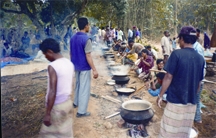
Social rites In matriarchal tribes, men do not inherit property. Men are neglected in their mothers' homes as well as in the houses of their wives. Among the Garos, after a mother's death, the daughters do not bear any responsibility for their father. However, among the Khasias, the daughters must fulfill that responsibility. The chief of the tribes of the Chittagong Hill Tracts and the Santals is called Raja, while the Khasias call him mantri or minister. Almost all tribes condemn adultery. If a couple has pre-marital sex it is obligatory for them to marry each other. Oraons give goat milk or mother's milk to a newborn to drink; others give honey. The new mother is given turmeric water to drink. Most tribes build a thorny fence around the house to protect the mother and the newborn from evil spirits; ojhas or vaidyas put the house under a protective spell and attempt to rid the mother and the child of any evil spell by incantation of mantras. Oraons keep an iron knife or an arrow near the head of the child and at times fling arrows. New mothers among the Chakma and Magh tribes do not bathe for a few days after delivery. On the sixth day after the birth, Manipuris clean the newborn, the mother and the hut where the delivery has taken place. A child's ear lobes are pricked immediately after birth. Garos avoid giving a baby an attractive name in order to avoid the evil eye. Usually on the fifth day of its birth or of the day of the week of its birth, an Oraon child is given a name in keeping with the names of its forefathers. Pigs, dogs and cocks are the favourite pets of tribal people. Oraons take great care of cows. At some festivals they wash the cows and then rub them with oil. On the day following the dark of the moon, they paint their courtyard with rice paste, burn incense in the cowsheds, wash farm implements, and put vermilion on them for good luck.
Disposing of the dead Tribal people sacrifice animals and weep to propitiate their dead so that their angry souls do not create trouble for the living. They then dispose of the body with gifts according to their capacity and later hold shraddha (feast) for the relatives of the dead. There is a basic uniformity in these rites despite some variations from tribe to tribe. The aborigines of Kushtia quickly bury their dead. The pallbearers take a dip in the river before returning home. Maghs and Chakmas cremate their dead two or three days after death. A priest's body is kept upto two or three months. Manipuris keep the dying person outside the house, on a banana leaf, while kirtans are chanted. Dead bodies are washed with the head of the corpse pointed northward. As the funeral procession proceeds to the cremation ground, kirtan is chanted. Earlier Manipuris used to bury their dead, but now they bury bodies of adolescents and cremate bodies of older persons. After disposing of the body, the pallbearers take a bath and dry their hands by holding them above a fire before entering their house.
The heir to the dead person carries a chopper in his or her hand for some time as protection against any evil spirit. The members of the family of the dead eat vegetables for twelve days and milk and banana for two days before the sraddha and sangkirtan. Among the Oraon, family members shave their heads after the funeral rites are over.
Houses All hill tribes build bamboo houses on raised platforms. They use ladders which are withdrawn at night so that wild animals cannot climb up. Maghs build houses on the flat ground. Oraons smear their houses with a plaster made of mud and cow dung. Usually their houses are made of earth, with thatched roofs, but they also build houses with fence made of shola (sponge wood). They draw leaves and vines on the mud walls of their houses. In general it can be said that the tribal folk culture of Bangladesh has similarities with that of many other Southeast Asian countries. [Ali Nawaz]
Bibliography Yamada Ryuji, Cultural Formation of the Mundas, Takai University Press, 1970; Bhupender Singh ed, The Tribal World and its Transformation, New Delhi, 1980; Tribal Cultures in Bangladesh, IBS, Rajshahi University, 1981.
See also tribal cultural academy; tribal dance; tribal languages.
